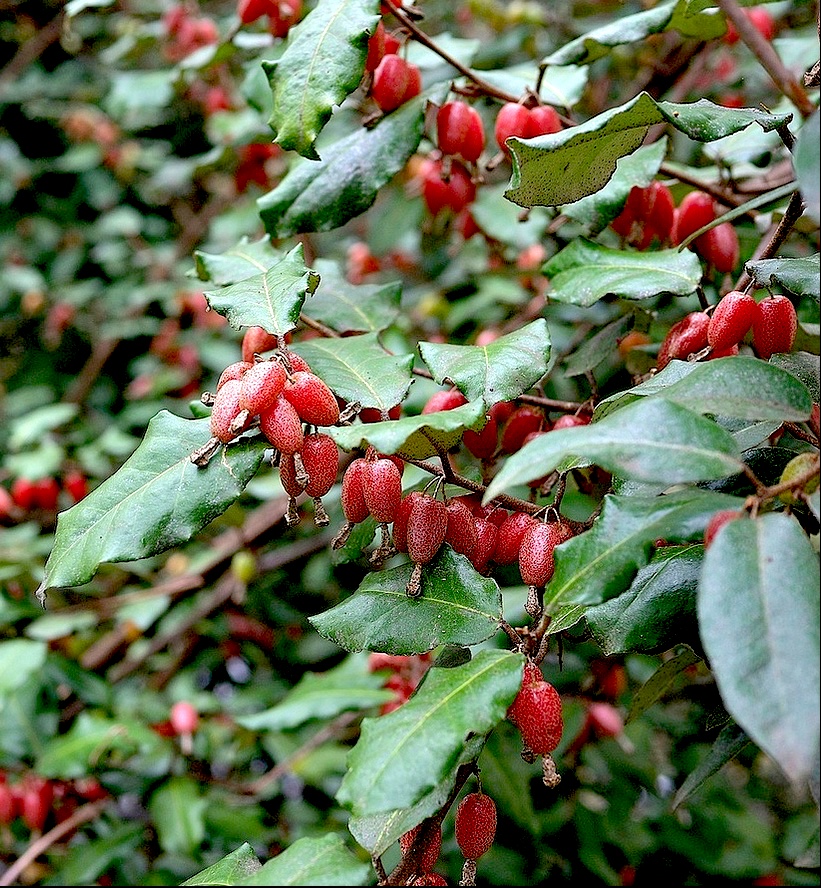
On new growth the fruits are easy to find, on trimmed shrubs the fruit often hides inside the foliage.
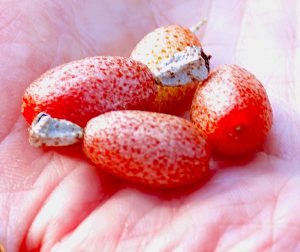
Ripe Silverthorn fruit are very sweet but taste awful when unripe. Photo by Green Deane
In many parts of the world February is the depth of winter; the coldest, snowiest, most miserable month of the year. But from Georgia south, it’s fruiting time for the exotic Silverthorn. Last Sunday in Jacksonville we rummage through a hedge of Silvethorn and found a few fruit on their way to being ripe which is red with silver and gold speckles. These were still gray/green. Unripe they are bitter and sour but when ripe very sweet and high in vitamin C. Silverthorn was originally planted as an ornamental in the 1800’s from the Carolinas south and west. Birds, who know food when they see it, have helped to naturalized throughout the South. The distinctive fruit reportedly has the highest amount — by percentage to weight — of the antioxidant lycopene. The slightly bitter, edible seed has omega-3 fatty acids. To read more about the Silverthorn go here.
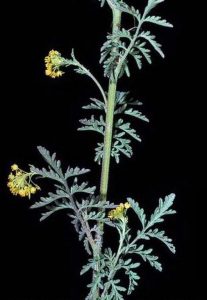
Mild Western Tansy Mustard in bloom.
For such a small plant the Western Tansy Mustard has a huge history. It’s called “western” because there was already a Tansy Mustard in Europe. The botanical powers of the day didn’t want to call that plant the Eastern Tansy Mustard so ours became the “western.” I’ve been seeing what-ever-its-name recently and it’s right on seasonal time. This little gray-green mustard is a winter annual here and is quite consistent where it likes to grow; dry spots with only natural watering. It’s fairly a common find this time of year in paddocks and other farm areas that include oak scrub (note that from a distance you could dismiss the Western Tansy Mustard as a young Ragweed but its leaves are finer.) The sample this weekend was growing along a side walk on a dry area of a college campus. Its minute seeds were a major staple for some Indian tribes and the leaves are edible raw or cooked. It is probably the mildest of our seasonal mustards. To read more about the Western Tansy Mustard go here.
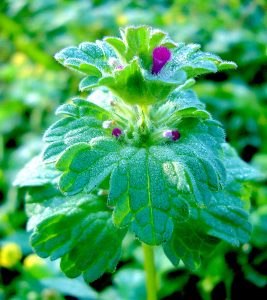
Henbit, one of the few “sweet” springtime greens. Photo by Green Deane
A local church has a raised-bed garden for their grade-school students. It has many of the expected plants, tomatoes for example. However lower temperatures have done them in but their cabbage is doing just fine. They were also raising cotton, always an interesting plant tufted with white patches. (Incidentally cottonseed oil is not edible until processed. It rapidly destroys potassium which 85% of Americans are already deficient in Magnesium. Cottonseed oil can also reduce fertility.) Of course, what I am more interested in is the garden weeds. They have a fine crop of amaranth, henbit and bitter cress. All three grow readily here in the winter though henbit is the only cool-season annual. Amaranth is a spinach substitute, and bitter cress is a peppery little mustard. Henbit, however, is unlike most winter greens. It is not spicy nor is it used like spinach. It’s mild and on the sweet side and was a welcomed taste to native foragers. Henbit is commonly used in salads but can get lost amid flavors. You can read about Henbit here.
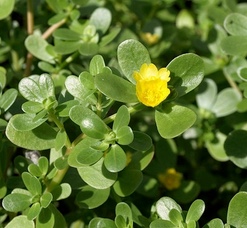
Common Edible Purslane
The Problem with Portulacas. Species in this genus cause some problems for foragers. At least one is edible, some perhaps less so, and others not at all. I don’t know of any reports of any being toxic per se so it’s not a dangerous genus at least in the Americas. Perhaps the best known and most edible is Purslane, Portulaca oleracea which has a simple yellow blossom — see left — that opens around noon and is very common. It’s an esteemed vegetable, near the top of the list of forageables, and high in vitamins C, A and melatonin. However, from there things can get confusing with P. pilosa, P. amilis, P. grandiflora, P. rubricaulis, P. smallii and P. umbraticola. Two are not common: I don’t ever recall seeing P. grandiflora, or P. rubricaulis. P. smallii is extremely rare and not found in Florida.
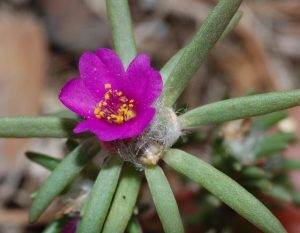
Portulaca pilosa, note the hairy stems.
Portulaca pilosa, the Moss Rose, or Rose Moss, is native to the southeastern United States. It gets lumped in with other Portulacas as edible but that has not been my experience. I have not found P. pilosa forager friendly. Every time I have tried to eat this little native, raw or cooked, it has mildly burned my throat and upset my stomach. Other folks report similar experience. It’s fairly easy to identify in that it has pink blossoms and pointy, hairy leaves. I put P. amilis, aka the Paraguayan Purslane, in the same category: It’s an import from South America and slightly less common than P. pilosa. It also has pink blossoms but flat leaves instead of pointed. It, too, tastes bad to me.
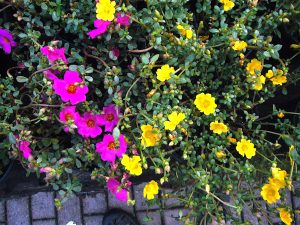
Portulaca umbraticola. Photo by Green Deane
Excluding the three uncommon ones, which seemingly only serious botanists find, that leaves P. umbraticola. Those are the fancy ones you see sold in garden centers. They are usually hybrids and will not seed true but can be propagated by cuttings. To add to the confusion they have been mistakenly sold in the past as P. grandiflora. They have large blossoms and come in a range of colors such as pink, orange, yellow and mixed. Are they edible? As far as I know no because they don’t taste good. A few decades ago I asked Forager Emeritus Dick Deuerling if they were edible and he said he didn’t know and hadn’t tried them. So while there are several Portulacas around I can only vouch for one as truly edible and safe, P. oleracea, the common weed with a simple yellow blossom that opens around noon.
 After many upgrades — and more upgrades needed — EatTheWeeds has opened a Go Fund Me page. My ETWs site has been up for over a decade. It took many years of work and study to create it. The site contains information on over a thousand of edible plants. I did all the research myself including many hours spent in university libraries scouring journals. There was also some first-hand indigestion along the way. As I tell people I wrote every article, no cut and paste. Every misspelling is authentically mine. (I don’t remove some of them as they are copyright traps. When someone copies my articles and include my spelling I can prove where they stole it.) The site has 145 related videos which I hope to get back on the site. They are currently on You Tube. The site’s Green Deane Forum has some 12,000 posts and needs to be expanded. The goal is to upgrade more — there are still bugs and features needed — do more videos and get a book published. More importantly I want to get the site in shape so I can will it to some organization that can maintain and upkeep it in future when I’m pushing up daisies. You can go to the Go Fund Me page here, or, if you want to use PayPal instead you can use this link.
After many upgrades — and more upgrades needed — EatTheWeeds has opened a Go Fund Me page. My ETWs site has been up for over a decade. It took many years of work and study to create it. The site contains information on over a thousand of edible plants. I did all the research myself including many hours spent in university libraries scouring journals. There was also some first-hand indigestion along the way. As I tell people I wrote every article, no cut and paste. Every misspelling is authentically mine. (I don’t remove some of them as they are copyright traps. When someone copies my articles and include my spelling I can prove where they stole it.) The site has 145 related videos which I hope to get back on the site. They are currently on You Tube. The site’s Green Deane Forum has some 12,000 posts and needs to be expanded. The goal is to upgrade more — there are still bugs and features needed — do more videos and get a book published. More importantly I want to get the site in shape so I can will it to some organization that can maintain and upkeep it in future when I’m pushing up daisies. You can go to the Go Fund Me page here, or, if you want to use PayPal instead you can use this link.
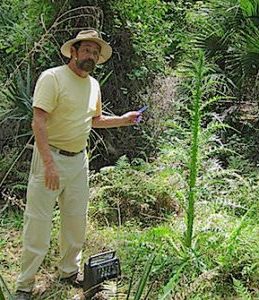
Foraging classes are held rain, shine, hot or cold. Photo by Nermina Krenata
Foraging Classes: It was in the upper 30’s when we started our foraging class this past Sunday. That’s okay… sometimes the class in south Florida starts out in the lower 90’s. It won’t be too cold or too hot for the foraging classes this weekend.
Saturday, January 20th, Spruce Creek Park, 6250 Ridgewood Ave. Port Orange, 32127. 9 a.m., at the pavilion. (First right after entrance.)
Sunday, January 21st, Bayshore Live Oak Park, Bayshore Drive, Port Charlotte. 9 a.m. Meet at the parking lot at the intersection of Bayshore Road and Ganyard Street.
Sunday, January 28th, Eagle Park Lake, 1800 Keene Road, Largo, FL 33771. 9 a.m. Meet at the pavilion by the dog park.
Sunday, February 4th, Red Bug Slough Preserve, 5200 Beneva Road, Sarasota, FL, 34233. 9 a.m.
Sunday, February 11th, Jervey Gantt Recreation Complex, 2390 SE 36th Ave., Ocala, FL, 34471. 9 a.m. Meet at the entrance to the pool, aka Aquatic Fun Center.
Saturday, February 17th, Wickham Park: 2500 Parkway Drive, Melbourne, FL 32935-2335. 9 a.m. Meet at the “dog park” inside the park.
Sunday, February 18th, Blanchard Park, 10501 Jay Blanchard Trail, Orlando, FL 32817. 9 a.m. Meet at the Pavilion east of the tennis courts near the YMCA.
Sunday, March 4th, Eagle Park Lake, 1800 Keene Road, Largo, FL 33771. 9 a.m. Meet at the pavilion by the dog park.
To read more about the classes go here.
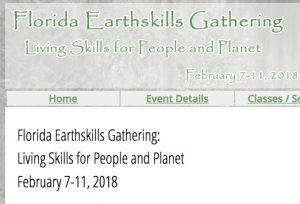
2018 Earthskills in Hawthorne Florida.
There are two conferences in February forager should be interest in: Earthskills in Hawthorn, and the Florida Herbal Conference near Lake Wales. I lead plant walks at both events. Earthskills is Feb 7-11 and the Florida Herbal Conference is Feb 23-25. Both are now accepting registration. You can register at Earthskills here. Because you read this newsletter you can get a discount for the Florida Herbal Conference. If you register for that conference between now and January 31 using the code FHC2018_GREENDEANE you can get a 30% discount. Keynote speakers this year at the Florida Herbal Conference are Linda and Luke Black Elk from the Standing Rock Reservation. Linda (of the Catawba Nation) is an ethnobotanist specializing in teaching about culturally important plants and their uses as food and medicine. She is a lecturer at Sitting Bull College in Fort Yates, North Dakota. Luke Black Elk (Thítȟuŋwaŋ Lakota) is a storyteller, grassroots activist, and traditional spiritualist. He has conducted research in water restoration, sustainable building design, and food sovereignty, and hopes to use these techniques to encourage a more traditional way of life among his people. Luke has lived on the Cheyenne River Sioux Reservation his entire life, becoming deeply involved in cultural and community activities. For more information about the Florida Herbal Conference go here.

Green Deane DVD Set
All of Green Deane’s videos available for free on You Tube. They do have ads on them so every time you watch a Green Deane video I get a quarter of one cent. Four views, one cent. Not exactly a large money-maker but it helps pays for this newsletter. If you want to see the videos without ads and some in slightly better quality you can order the DVD set. It is nine DVDs with 15 videos on each for a total of 135 videos. Many people want their own copy of the videos or they have a slow service and its easier to order then to watch them on-line. The DVDs make a good gift for that forager you know especially on long, cold winter months. Individual DVDs can also be ordered or you can pick and choose. You can order them by clicking on the button on the top right hand side of this page (if your window is open wide enough.) Or you can go here.

Green Deane Forum
Want to identify a plant? Looking for a foraging reference? Do you have a UFO, an Unidentified Flowering Object you want identified? On the Green Deane Forum we chat about foraging all year. And it’s not just about warm-weather plants or just North American flora. Many nations around the world share common weeds so there’s a lot to talk about. There’s also more than weeds. The reference section has information for foraging around the world. There are also articles on food preservation, and forgotten skills from making bows to fermenting food. One special section is “From the Frightening Mail Bag” where we learn from people who eat first then ask questions later. You can join the forum by clicking on “forum” in the menu.
This is weekly issue 287 and note there is one more article below.
If you would like to donate to Eat The Weeds please click here.
Are cattails all they’re reported to be? Euell Gibbons called them the “Supermarket of the Swamp.” Under cultivation it’s doubtful any species produces more starch per acre than cattails, nearly 6,500 pounds. On paper cattails seem to be the perfect foraged food. Reality, however, throws some water on that.
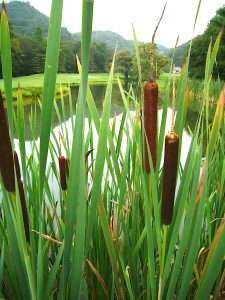
Cattails in North Carolina. Photo by Green Deane
There is no doubt that if I needed food I would turn to the cattail. It has edible parts from the green top to the mucky bottom. And as survival instructors are fond of saying if you have cattails you have four of the five things you need to survive: Food, water, material for fire and material for shelter. All you are missing is companionship, which is debatable. Another plus is that cattail rhizomes are available every day of the year though you may have to break the ice to harvest them. My disagreement is not about their edibility or usefulness but rather perspective and their position in the hierarchy of foraged food. Cattails are always placed near the top of the foraging list whereas perhaps they should be nearer the middle of the pack.
There are definitely two sides to the species. On the fast food side are edible male and female parts of the unusual flower including pollen (and fuzz if you have a tough tummy.) Then there are the inner lower stalk, stolons, and sprouts growing off the rhizome. Requiring a bit more work, the rhizomes can be roasted for the starch inside. That would get the plant a solid rating as a forageable. But then there’s the slow food side, the labor-intense extraction of the starch to make a flour for various uses. I would call that the cultivated side and over emphasized.
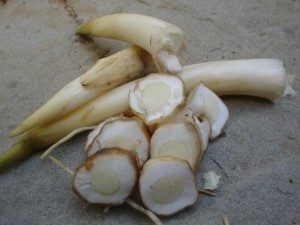
Cattail rhizomes need processing.
Cattails would make a good commercial crop for the starch. It could be grown in unused swamp land and be mechanically harvested — keeping us dry. No doubt a more efficient means of starch extraction could be devised besides water-intensive settling tanks. One possibility is grinding clean dried roots to separate the stomach-irritating fiber from the starch. The rough fiber is why we just don’t eat the rhizome as it is, although another issue is the cattail usually grows in mud that does not smell appetizing. Even cleaning the roots to dry them takes labor, and water.
Cattails should be on everyone’s foraging list. They are significant and reliable wild food. But one has to know what you want to do with them. It is not enough to know they are edible. The “how” is very important as well as what resources you have on hand and how much time you can dedicate to the edible task. Cattails are good but not great.


A BOOK! That’s GREAT NEWS! Your fans have been awaiting a Green Deane’s Guide to Wild Foods for… a very long time.
A big project, yes. You have the knowledge, the research skills, the direct experience, the appreciation of how important the preparation aspect is, and an engaging style of writing that will make your book GREAT!
We will contribute, but it will likely show up under another name. ‘A rose, by any other name…’ is still edible, though, eh?!
Thank you, thank you, THANK YOU for all you have shared over the years.
Best regards~